基于行为生物识别的零信任体系结构无意识连续认证协议
IF 5.7
2区 计算机科学
Q1 COMPUTER SCIENCE, HARDWARE & ARCHITECTURE
引用次数: 0
摘要
零信任架构在全球范围内受到广泛关注,是网络安全领域的重要发展。在零信任体系结构中,针对传统静态认证机制对网络安全造成的威胁,提出了持续认证(CA)策略。然而,大多数研究都集中在设备到设备认证或用户认证上。尽管实现了CA机制,但这种限制导致了身份欺骗或凭证盗窃的风险,从而得出了身份验证用户和设备之间的同等重要性。此外,考虑到用户的CA,必须面对用户身份验证疲劳带来的问题。为了应对这些挑战,本研究旨在引入一种基于零信任概念和行为生物识别的无意识CA协议(UCAP)。UCAP利用击键动力学行为作为一致评估用户信任级别的主要因素。此方法支持通信密钥的持续更新,以保持设备和用户的健壮身份验证。通过形式化工具检验了UCAP的鲁棒性,实验结果显示了令人满意的性能。本文章由计算机程序翻译,如有差异,请以英文原文为准。
Unconsciously Continuous Authentication Protocol in Zero-Trust Architecture Based on Behavioral Biometrics
Zero-trust architecture has received massive attention globally and been a significant development in the field of cybersecurity. Within zero-trust architecture, the continuous authentication (CA) strategy has been proposed to counter the network security threats posed by traditional static authentication mechanisms. However, most studies have focused on either device-to-device authentication or user authentication. This limitation results in risks of identity spoofing or credential theft despite the implementation of the CA mechanism, thus concluding the parity in significance between authenticating users and devices. Furthermore, considering the CA of users, it is essential to face the issue posed by user authentication fatigue. In response to these challenges, this work aims to introduce an unconsciously CA protocol (UCAP) based on zero-trust concepts and behavior biometrics. UCAP utilizes the behavior of keystroke dynamics as a main factor in consistently evaluating the user trust level. This method enables the continual updating of communication keys to preserve robust authentication of both devices and users. The robustness of UCAP has been examined through formal tools, while the experimental outcomes have shown satisfactory performance.
求助全文
通过发布文献求助,成功后即可免费获取论文全文。
去求助
来源期刊

IEEE Transactions on Reliability
工程技术-工程:电子与电气
CiteScore
12.20
自引率
8.50%
发文量
153
审稿时长
7.5 months
期刊介绍:
IEEE Transactions on Reliability is a refereed journal for the reliability and allied disciplines including, but not limited to, maintainability, physics of failure, life testing, prognostics, design and manufacture for reliability, reliability for systems of systems, network availability, mission success, warranty, safety, and various measures of effectiveness. Topics eligible for publication range from hardware to software, from materials to systems, from consumer and industrial devices to manufacturing plants, from individual items to networks, from techniques for making things better to ways of predicting and measuring behavior in the field. As an engineering subject that supports new and existing technologies, we constantly expand into new areas of the assurance sciences.
 求助内容:
求助内容: 应助结果提醒方式:
应助结果提醒方式:


